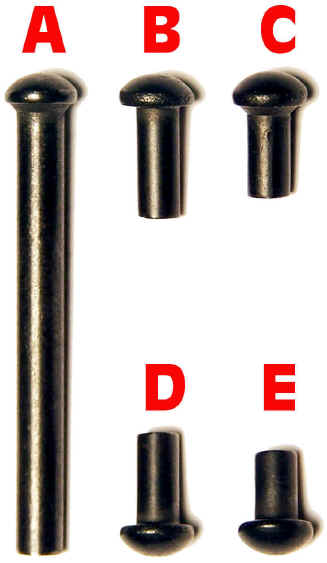

- Ak rivet bolt cutter modification install#
- Ak rivet bolt cutter modification plus#
- Ak rivet bolt cutter modification free#
We install the piston, bolt, and guide spring, snap on the cover, and run the bolt carrier, feeling for binding. Check the feel and, whoa, that ALG trigger is sweet. We rough fit the ALG Defense AKT trigger kit then load it into the receiver. The handguard and gas tube are installed and we head for the fire controls. We pull the assembly, check the headspace, and drive the barrel pin in and, yep, check headspace again. As it gets close, we insert the feeler gauges we talked about earlier, taking the guesswork out of finding the stopping point. A penny protects the crown from the ram as thousands of pounds of pressure force the barrel into the trunnion. We grease up the barrel, put it in the AK Builder barrel press and line things up. PCG’s fledgling Cerakote operation might be low volume, but it’s high quality. Rodney Backus, with the Park City Gun Club, Cerakotes the barrel of our AKM. We were careful to take material off from back to front since we want as much ejector contact at the business end as we can get. Childers leaves the rail tang long so it can be filed for a precise fit to the bolt. As the bolt retracts, the brass hits the tang and gets chucked. The bolt has a slot that runs its length for the rail/ejector. On an AKM, the ejector is just a protruding tang on the left bolt guide rail. Pappas suggests rounding over the end of the long rivets so they come out of mashing process with an aesthetically pleasing mushroom shape.ĭrop the bolt in, and check the ejector clearance. The rear trunnion is treated similarly as the front trunnion, except we have two long rivets instead of shorties. Some filing of the mag well is normal, but ours needed no attention. The fit of the trigger guard can affect the magazine release, so carefully test the parts with many different types of magazines. The four front and one rear trigger guard rivets get the business. We move on to the trigger guard and spacer. The six short front rivets are crushed into place using the Toth Tool rivet jaws mounted on a 24-inch bolt cutter. Reposition the fixture for each rivet hole. Then slide it around a drill press table to line up the holes with the drill bit, lock it down, then slide the receiver on to drill a rivet hole. Doing so leaves only the rivet core to hold the parts in shear, and the rivet will eventually snap. Some builders mistakenly relieve material from the receiver here to get the swell-neck rivet to sit flush. This is an important step that locks the receiver and trunnion together when a swell-neck rivet is installed. We deburr and chase all the holes with a drill and a Dremel, and dimple the two bottom holes into a matching recess in the trunnion using the press and the riveting jig. We repeated the same process for the remaining five front rivet holes. The hole is drilled and so long as nothing moves, the rivet hole in the receiver and the trunnion are lined up for success. We line up the rivet hole in the trunnion with the bit and clamp the fixture in place, then we slide the receiver into the trunnion.
Ak rivet bolt cutter modification free#
Now that the trunnion is free of the barrel, it’s fixed in the AK Builder drilling fixture. With the pin out, the barrel is pushed out using the hydraulic ram with the trunnion supported by the AK Builder Barrel Press fixture. The work begins with removing the partially installed barrel pin using the Forbus barrel pin tool guiding the hydraulic press’ ram. It’s part of the welded-in guide rail, and it’s usually left long and needs to be filed down to allow the bolt to pass over it. The Work Beginsįiling the ejector in the Childress AKM receiver. With the feeler gauges stacked in the gap during reassembly, they act as a stop, ensuring the barrel is seated at the same depth it was headspaced at. We checked our AK-Builder built barrel and used a set of automotive feeler gauges to record the gap between the front trunnion and the rear sight base.
Ak rivet bolt cutter modification plus#
There aren’t many showstoppers on the AKM, but plus or minus a couple thousandths of headspace can result a rifle which fires out of battery or separates the heads from cases. Even so, if there’s one thing, just one thing, that you take away from this article, it’s the importance of checking the headspace. We didn’t have to worry about fitting the gas block and sight block, or drilling/reaming the barrel pinhole. We used specialized AK gunsmithing tools from AK Builder, Toth Tools, and Robert Forbus Engineering Works in addition to a standing hydraulic press as well as some common tools, such as a drill press, rubber mallet, Dremel, and files. Unless you’re as lucky as we are, you’re not going to be able to pillage your buddy’s shop for riveting tools and alignment fixtures. You get a single shot at installing one, and the tools to work with them aren’t common, either. The rivets in the recessed area of the AKM’s front trunnion are best reached with the Toth Tool and Engineering Rivet Jaws.


 0 kommentar(er)
0 kommentar(er)
